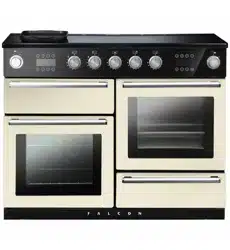Loading ...
Loading ...
Loading ...

14
F
TOP TIPS
Not sure of the capacity of your loaf tins?
• A one pound loaf tin will hold 800ml of water
• A two pound loaf tin will hold 1.5 litres of water.
• Cover the dough while it is proving with greased
cling film, be careful not to anchor the cling film too
tightly so that it prevents the dough from rising.
Bread Proving Drawer
The Bread Proving Drawer is found on the right at the base of
the cooker (Fig. 2.15). Within the Bread Proving Drawer there
are slots in the base to allow warmed air to ow through into
the drawer from the element underneath.
The Bread Proving Drawer temperature is ideal for proving
all sorts of yeast dough from sweet to savoury, gluten free
to sourdough, dough made from fresh yeast and dried,
bread mixes and recipes from the Rangemaster Good
Housekeeping Cookery book.
Pre heat the drawer so that it is warm and ready for your dough.
Turn the knob clockwise (Fig. 2.16). There is no need to set
the temperature, this is already set.
The Bread Proving Drawer has space for:
• Baking trays, no larger than 340mm x 340mm, to prove
bread rolls or buns; these can then be put straight into a
preheated oven after proving.
• To prove 2 trays at once in the drawer use a cooling
rack or trivet over the top of one tray with the other on
top, remember to allow space for the dough to expand
during the proving time.
• 3 litre bowl full of dough
• 3 x 2 pound loaf tins
• 4 x 1 pound loaf tins
The time needed for proving will depend upon the dough
type and the amount. Refer to the recipe for guidance and
check the dough during the proving time.
If a large baking tray is used, place a cooling rack on to the
base of the drawer, and put the tray on top, this will allow the
warmed air to reach the dough.
When preparing larger quantities of yeast dough, containing
500g or over of our, divide the dough into 2 bowls or
containers, this will make proving in the drawer easier.
Keep an eye on the dough while it is proving; fresh yeast can
work quickly especially if it has had a rst fermentation stage
(sometimes called sponging). Sponging can help produce a
slightly lighter loaf.
The Bread Proving Drawer can be used for storage. If you have
used the Bread Proving Drawer, switch it o and wait until the
drawer cools before storing any items.
NOTE: The Bread Proving Drawer will not warm plates.
Cleaning
Clean the inside of the drawer with hot soapy water and a
soft cloth, rinse and dry.
The Bread Proving Drawer is ideal for storing baking trays
and other cooking utensils.
It can get very warm, so do not store anything in it that may
melt or catch re. Never store ammable materials in the
drawer. This includes paper, plastic and cloth items, such as
cookbooks, plastic ware and towels, as well as ammable
liquids. Do not store explosives, such as aerosol cans, on or
near the appliance.
Fig. 2.15
Fig. 2.16
Loading ...
Loading ...
Loading ...
